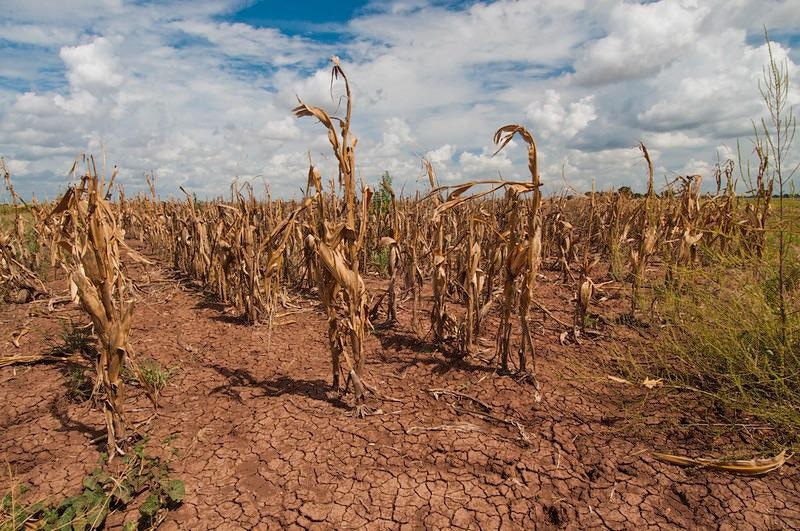According to a new research article in the AGU journal Earth’s Future, agricultural water scarcity is anticipated to increase in over 80% of the croplands across the world by the year 2050.
 A drought-stricken cornfield in Texas in 2013. Image Credit: Bob Nichols/USDA.
A drought-stricken cornfield in Texas in 2013. Image Credit: Bob Nichols/USDA.
The study analyzes present and future water needs for worldwide agriculture and estimates whether the available water levels, either from irrigation or rainwater, will be adequate to satisfy those requirements under climate change.
To accomplish that, the scientists created a new index to compute and predict water inadequacy in agriculture’s two key sources: irrigation from lakes, rivers, and groundwater, known as blue water, and soil water that comes from rain, known as green water. It is the first study to apply this complete index globally and estimate global green and blue water scarcity as a result of climate change.
As the largest user of both blue and green water resources, agricultural production is faced with unprecedented challenges. This index enables an assessment of agricultural water scarcity in both rainfed and irrigated croplands in a consistent manner.
Xingcai Liu, Study Lead Author and Associate Professor, Institute of Geographic Sciences and Natural Resources Research, Chinese Academy of Sciences
In the last century, water demand globally has increased two times as rapidly as the human population. Water scarcity is already a problem on all the continents with agriculture, creating a major risk to food security. Regardless of this, the majority of water scarcity models have failed to take a detailed look at both green and blue water.
Green water is the quota of rainwater that is present for plants in the soil. Most of the precipitation turns into green water, but it is frequently ignored because it is imperceptible in the soil and cannot be withdrawn for other uses. The amount of green water present for crops relies on the quantity of rainfall an area gets and the amount of water that is lost because of evaporation and runoff.
Other factors such as farming practices, the type of soil, vegetation covering the area, and the slope of the terrain also have a role to play. As rainfall and temperature patterns change due to climate change, and farming practices increase further to cater to the requirements of the growing population, the green water available to crops will also likely vary.
Mesfin Mekonnen, an assistant professor of Civil, Construction, and Environmental Engineering at the University of Alabama, who was not involved in the research, said the study is “very timely in underlining the impact of climate on water availability on crop areas.”
What makes the paper interesting is developing a water scarcity indicator taking into account both blue water and green water. Most studies focus on blue water resources alone, giving little consideration to the green water.
Mesfin Mekonnen, Assistant Professor of Civil, Construction, and Environmental Engineering, University of Alabama
The scientists learn that under climate change, worldwide agricultural water scarcity will deteriorate in nearly 84% of croplands, with a loss of water supplies triggering scarcity in approximately 60% of those croplands.
Sowing Solutions
Variations in available green water, because of unstable precipitation patterns and evaporation due to higher temperatures, are presently estimated to affect around 16% of worldwide croplands. Incorporating this crucial dimension into one’s understanding of water scarcity could have consequences for the management of agricultural water.
For example, the Sahel in Africa and Northeast China are estimated to get more rain, which may help lessen agricultural water scarcity. Nevertheless, lesser precipitation in northwest India and the midwestern United States may result in increased irrigation to aid intense farming.
The new index could benefit countries to compute the risk and causes of agricultural water scarcity and formulate strategies to decrease the effect of future droughts.
Numerous practices help protect agricultural water. No-till farming boosts water to infiltrate the ground, mulching decreases evaporation from the soil, and regulating the timing of plantings can properly align crop growth with shifting rainfall patterns. Furthermore, contour farming, wherein farmers plow the soil on sloped land in rows maintaining the same elevation, stops soil erosion and water runoff.
Longer term, improving irrigation infrastructure, for example in Africa, and irrigation efficiency would be effective ways to mitigate the effects of future climate change in the context of growing food demand.
Xingcai Liu, Study Lead Author and Associate Professor, Institute of Geographic Sciences and Natural Resources Research, Chinese Academy of Sciences
Journal Reference:
Liu, X., et al. (2022) Global agricultural water scarcity assessment incorporating blue and green water availability under future climate change. Earth’s Future. doi.org/10.1029/2021EF002567.